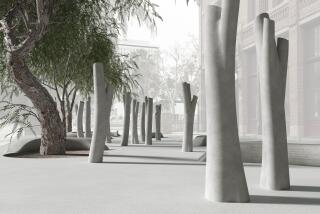Victims of Texas A&M; Bonfire Rite Honored
- Share via
COLLEGE STATION, Texas — On the fifth anniversary of the deadly collapse of logs stacked for a bonfire that was an annual rite at Texas A&M; University, thousands gathered Thursday to remember the victims at the dedication of a permanent memorial.
The $5-million granite-and-bronze monument, built on the spot where 12 people died and 27 were injured when a 59-foot tower of logs being constructed unexpectedly buckled, will “forever hold and share their memory,” said Jerry Ebanks, father of one of the victims, Michael Ebanks.
The students weren’t just assembling a massive pile of kindling for a pep rally, Ebanks said at the dedication ceremony. “They were building camaraderie, the strength and depth of which is hard for others to understand,” he said.
The Aggie bonfire -- or simply Bonfire, as it is called here -- was a 90-year-old tradition meant to symbolize the school’s burning desire to beat archrival University of Texas in their annual football game. But since the 1999 tragedy, the on-campus bonfire has been banned as lawsuits filed by families of the dead and injured wind through state and federal courts. An A&M; investigative commission in 2000 blamed the collapse on faulty construction techniques and inadequate supervision of students.
“We’ve had to adapt to life without Bonfire on campus,” said Chip Thiel, one of the students injured when the pile of 5,000 logs fell.
Thiel asked the students, family members and alumni gathered Thursday to close their eyes as he recalled the thrill of working on the stacks.
“It was the largest bonfire in the world. It was bigger than necessary, but we wouldn’t have had it any other way, with our grunts and groans and blisters.... We burned it in an arrogantly flamboyant ceremony that said: ‘We’re the Aggies,’ ” he said, his voice filled with emotion.
Thiel said the memorial, in a polo field east of the university entrance, would be a tribute to the dead and injured as well as a symbol of the spirit and unity of the bonfire tradition.
Designed by a San Antonio-based architectural firm, the memorial is divided into three sections. Inside “Tradition Plaza” is a large granite wall inscribed with a poem that was read before each year’s bonfire was lighted.
A pathway leading from the plaza is bordered by 89 large slabs of rock, a granite timeline marking the years the bonfire burned from 1909 to 1998. A black stone marks 1963 -- the year the bonfire was not lighted because of the assassination of President Kennedy.
The centerpiece of the memorial is a large circle of 12 granite arches lighted at night to represent a bonfire. Inside the 170-foot-diameter circle -- placed where the bonfire stack’s center pole stood -- is a round piece of black granite inscribed with the date and time of the collapse.
The 16-foot-high rectangular arches face the hometown of each victim who died. Twelve-foot-high bronze portals within each arch are embossed with a victim’s portrait, his or her name, signature and class year. Recollections from family members or excerpts from victims’ writings are also etched inside.
Smaller, unsanctioned bonfires have been built off campus since the collapse by students determined to keep the tradition alive. Chemical engineering student Scott Smith, 21, has spent most of his spare time lately hauling logs out of the woods for this year’s renegade bonfire.
But at 2:42 a.m. Thursday, he was at the memorial for a ceremony marking the time the stack fell in 1999. Then, he went back to work on the bonfire.
Smith, a member of the student Senate, said that “most students would like to see Bonfire back on campus.” But he worried that safety-conscious administrators might hire professional contractors to assemble the logs.
“It shouldn’t be on campus unless it is what it was,” Smith said. “You shouldn’t let other people do the work. Bonfire isn’t just a stack of wood. It’s the heart of being an Aggie.”
More to Read
Sign up for Essential California
The most important California stories and recommendations in your inbox every morning.
You may occasionally receive promotional content from the Los Angeles Times.













